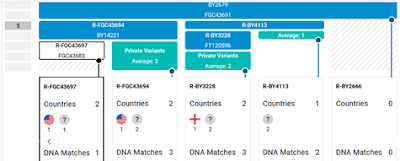Those of us who are veterans of atDNA testing have long preached "test the oldest generation of the family." For atDNA testing this is still great advice. However, there may be times when we can learn from testing the youngest generation.
I know that there are various schools of thought about how old a child should be before they are tested. That topic is an important one which I will not deal with here. I have long tested family members of all ages. By so doing I discovered several years ago that grandchildren do not inherit exactly one-fourth of their atDNA from each grandparent. You can see my blog post about that (I got it wrong).
More recently I bought a BIG Y 700 test for my oldest grandson. Until now ySTR tests have primarily been to find matches among other test-takers. ySNP tests have been primarily to discover new branching points along the Y chromosome since possibly sixteen million or more locations can be explored. As his results have come back, I have so far learned two things:
- Either my grandson or his father is a "mutant." My grandson matches me on 110 of the first 111 markers over which FTDNA tests ySTRs. In one of the two conception events a mismatch occurred.
- Prior to my grandson's test results, I had two "private variants" not found in the genome of any man previously tested. Now both of those variants are shown in the box with the white background in the column on the left below. Now that two men have had those ySNPs show up in their tests, they have become "named SNPs" and added to the BIG Y Tree, In addition my grandson's test results had identified a new "private variant" which had not previously been discovered.
So what if anything have I learned about my family history by testing my grandson? In the test of his first 111 ySTR markers, we had one mismatch. This allows FTDNA's YDNA TiP tool to predict that we have a 78% chance of sharing a common patrilineal ancestor within 2 generations. (The correct answer.) The TiP tool predicts we have a 95 percent chance of sharing that common ancestor within 4 generations. He is not my closest match over the first 111 ySTR markers. I have one cousin who is an exact match over those markers. However, that cousin shares 6 Big Y STR differences with me when all 590 STRs tested are considered. My grandson shares only 2 STR differences with me over all STRs 659 tested. Since ySTRs can mutate at random, when more are tested the results are more accurate. The results confirm that he is in fact probably relate to me within two generations along my patrilineal line.
The two ySNPs in the white box above, R-FGC43697 and R-FGC43683 are equivalent SNPs for genealogical purposes at least for now. We really can't tell which occurred first. What these designations tell us is that these SNPs are part of the R1b male haplogroup and they are #43,683 and #43,697 of the ySNPs discovered by and named by the Full Genome Corporation lab. Other than that these numbers have no significance. For now my grandson and I are the only two men who have mutations at these locations. We would expect any of our male descendants to inherit them. They would become a sort of genetic signature of our particular family line of descent--our genetic coat of arms. Early indications are that these mutations may have occurred about a hundred years ago. More testing by family members will be needed to learn more specifically when they may first have occurred. Below is a timeline chart generated by Rob Spencer's Tracking Back tools:
This suggests that ySNP R-FGC43697 may have been created by a mutation in a birth event occurring around the beginning of the 20th century. Also note that my previous haplogroup assignment of FGC43694 as well as other nearby cousins like all of us under ySNP R-BY2666 appear to be connecting back as far as 1,500 years ago. Several SNPs back then have yet to be separated out time wise.
The results of my grandson's test have pushed my own terminal ySNP down into genealogical time--perhaps to the last two or three generations. This has caused us to order a BIG Y 700 test for my son. That may be overkill. I would have considered it to be a few months ago. However, it will show us a couple of things at the very least.
- Did the one mutated ySTR between me and my grandson occur when my son was conceived or when my grandson was conceived?
- Will my son's terminal ySNP cover my grandson's "private variant" or is that variant the unique marker for my grandson?
It is an expensive way to add these two bits of information to our family history but I could plan a genealogical research trip that could cost more that the test with less guarantee of new information.





No comments:
Post a Comment